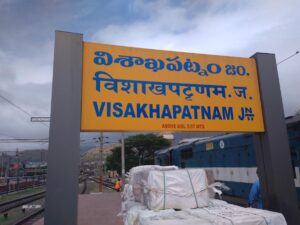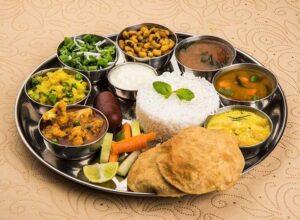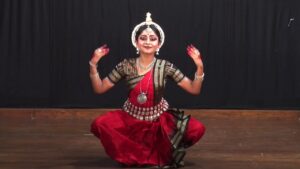Dancing Around India: Chapter 6 – Odissi
— by Srishti Bhattacharyya
–Reading Time – 25 min Approx
After Sunetra returned to her hotel from the A&A Dance Studios, she had packed up her things and spoken to the receptionist asking if the hotel could arrange a car to take her to the Visakhapatnam railway station. The next day, she was supposed to get on the train which would take her to Puri, Orissa.
Her train was at around 10:30 AM. Sunetra woke up when her alarm rang at 8:00 AM. After a quick shower and a light breakfast which consisted of plain toast and a glass of orange juice, she checked the room to make sure that she had packed everything. By the time she came down to the hotel lobby, the time was half-past nine and her car was already waiting in their driveway.
 The roads were more or less clear. The ride took a mere twenty-five minutes and Sunetra had reached the railway station easily. Her two bags were light enough but her left leg had been aching since the morning. So she offered a coolie some money and gave her bags to that young man to carry.
The roads were more or less clear. The ride took a mere twenty-five minutes and Sunetra had reached the railway station easily. Her two bags were light enough but her left leg had been aching since the morning. So she offered a coolie some money and gave her bags to that young man to carry.
The train was already at the station. Sunetra, with her ticket in her hand, walked through the platform until she came across her compartment number. She went in first followed by the coolie.
The loud sounds of the people trying to find their seats had her scrunching her face in discomfort. She looked around with squinted eyes and a frown on her face. However, the frown soon fell when she noticed that her seat was by the window. A smile adorned her features as she pointed to her seat and moved slightly. She made space for the coolie to go in and place her luggage under the seat and paid him for his help.
The coolie took the money, joined his hands to say ‘Namaste’ and walked away from her. Sunetra still had a smile on her face as she sat down in her seat. The train still had fifteen more minutes to leave, and she had decided to start reading the book she had bought on Odissi dance form.
The Journey with Odissi:
Odissi – An Indian Classical Dance Form by Hejmadi Priyambada Mohanty, Sunetra sighed blissfully. What could be better than to have the wind blowing across her face as she read about her interest while visiting a cultural city to explore?

She opened the book and started on the reading. Odissi, like all the other Indian classical dances, had first originated in the ancient temples in Orissa.
Originally, it was performed only by the women who through this dance told spiritual and religious stories. In the ancient Sanskrit text of Performance Arts, Natya Sashtra, the foundations of Odissi can be found. In all the 108 dance units that are described in the text, the highlands of Odissi can be found.
Pankaj Charan Das, Gangadhar Pradhan, Deba Prasad Das, and Kelucharan Mahapatra were the four major Gurus who revived the Odissi dance form in the late 1940s. Sanjukta Panigrahi, a student of Kelucharan Mahapatra had popularised the dance form by performing various shows all over India and abroad. Guru Mayadhar Raut gave Odissi the much deserved classical dance status.
Kasturi Pattanaik was another individual who played a huge role in the development of traditional Odissi dance into a contemporary form. She, with her creations, had left a deep and artistic impact in the minds of the people which affected the growth and evolution of Odissi. Her new concepts, themes and techniques, helped Odissi to develop from its former Mahari, Gotipua to its current form.
The wind softly hit her face and Sunetra felt the inertia change which made her look up. The train had started. Her journey of six hours has begun. She took a sip of water from the small handbag she kept on her side and continued with her reading.
Sunetra didn’t realise how much time passed by as she kept reading the book. The wind blew through her hair and she kept her full attention focused on the pages.
She took a few breaks while reading the book, in order to eat some snacks. That was all she took or needed to finish a hundred and fifty pages book in one reading. By the time Sunetra reached the Puri Railway Station, she knew almost everything there was to know about the Odissi Dance Form.
Her plans in this city were different. She planned on visiting the famous places for sightseeing in this city. Sunetra had heard a lot about the architectural wonders of the city and about the various dance figurines that one can find in those temples. She wanted to visit those places and see them for herself.
The time was twenty minutes past six when Sunetra stepped down on the Puri Railway Station. She again paid one of the coolies to carry her luggage and put it in an auto-rickshaw. After asking her where she wanted to go, the auto driver started towards the beach, by the side of which she had booked her hotel. Once again as she saw the roads of the city, her mind raced back to what she just read.
The understanding of odissi:

Like all classical dance forms, Odissi also has units, which are called Bhangas consisting of body movements and positions. The motions we see in this dance are – rising up called ‘Uthas’, sitting down called ‘Baithas’, standing called ‘Sthankas’. The movements that we see on the dance floor are called ‘chaalis’, each of which can be linked to the emotions which are mentioned in the Sanskrit texts. An example of this is ‘Burhas’, a movement to show excitement.
The dancers are assigned a small zone or area on the floor within which all the movements will take place, even the spins are to be performed within that small area allocated to the dancer. The foot movements are called ‘Pada Bhedas’. Most Indian classical dances have four basic dance units, but Odissi has three. They are –
- Sambhanga – Sitting in a square position, weights equally distributed over the two legs, arms held up and elbows bend.
- Abhanga – legs bend deeply so that weight can be transferred from one leg to another, knees bent outwards and hips extending to the side.
- Tribhanga – the body is bend in three folds, looking like an ‘S’, the torso bent in one direction while the head and knees are held in opposite direction.
Mudras, also known as hand gestures are used in Odissi like all the other classical dance forms to convey mood, emotion and feelings. In total there are 63 mudras which are grouped into three categories. Those are –
- Samyukta Hasta – 28 Prakar Mudras made with both hands, to indicate things like flags, animals, moon, and many more.
- Asamyukta Hasta – 24 Prakar Mudras made by a single hand to communicate actions like embrace, prayer, salute, arrow, energy.
- Nrutya Hasta – the pure dance Mudras.
The costumes are colourful clothes which are complemented by jewellery and makeup. The saree the dancers wear are of local silk called ‘Pattasari’ and is worn with pleats so that they allow maximum flexibility.
The jewellery includes silver pieces since silver is a metal much appreciated based on the traditions. The hair is pulled up and tied in a very beautiful bun, which resembles the Vedic Temple Spire, the hair is parted in the middle, showing what is called a ‘Seenthi’. There might also be jewellery shaped like the moon and white flowers and even a crown called ‘Mukut’ adorned with peacock feathers. There is also a ‘Tika’ on the forehead and the eyes are beautifully decorated by Kajal.

The dancers also wear ear covers called ‘Kapa’. They wear earrings too which decorate the side of their heads. Armlets called ‘Bahichudi’ are worn on the upper arm, bangles on the wrist and an elaborate belt is worn on the waist, the purpose of which is to tie one end of the Saari. They also wear ‘ghungroo’ like the other classical dances and the palms and soles are coloured red with ‘Alta’.
The male performers wear pleated ‘dhoti’ so that they can move freely. Their upper body remains bar, with the exception of a translucent sheet that is wrapped around their shoulder, tucked under a wide belt.
The room that Sunetra booked for herself was facing the beach. She could see numerous people walking on the beach. The first thing she did on entering the room was going into the Veranda, closing her eyes, and taking a deep breath as she looked on to the scenery. Her one regret in Vishakhapatnam was that her hotel room was not facing the Rushikonda Beach.
The Odia Cuisine:
 Dinner included the Odissa Thali, which included Daalma, Aloo Posto, Besan ki Tarkari, Tomato Chutney, Spinach and Onion Pakoda, Meethi Khichudi, Janta Roti and Roasted Rice Kheer.
Dinner included the Odissa Thali, which included Daalma, Aloo Posto, Besan ki Tarkari, Tomato Chutney, Spinach and Onion Pakoda, Meethi Khichudi, Janta Roti and Roasted Rice Kheer.
Sunetra freshened up before eating her dinner and lied down on the bed to get some sleep. After a day-long journey, she easily fell asleep as soon as she hit the bed.
The next day, Sunetra wanted to go to the beach in the morning but she was too tired and woke up late. In the end, she showered to get ready for her day’s routine. Sunetra had asked the hotel to prepare a car for her trip and the hotel had also provided her with a guide in the form of the driver.
The sightseeing started with the Jagannath Temple in Puri. She spent quite a while admiring the beautiful architecture and the feel of the stony texture of the ground under her feet. She even entered the temple to see the pray to the idols in the temple.
Apart from that, she visited the Mashir Bari (Lord Jagannath’s maternal aunt’s house), Sudarshan Crafts Museum and Uday Giri. Her next destination was the Konarak Sun Temple. On reaching that temple, she first had her lunch in a small local restaurant. They provided her with a Veg thaali, where she once again had puri, bhaaji, rice, aloo posto, and a mixed vegetable Curry.
When lunch was over, and she had finally entered into the premises of the Sun temple, she wondered if her driver had left the best for the last. The architecture of the temple was the best that she had seen in Orissa till now.
She was just walking around the temple when she saw a girl walking up to her.
“A dance lover?”
Sunetra turned around to look at the girl beside her.
“Many people admire these,” the girl said, “but very few people look at them like they are star-struck.” She smiled, “Hi, I am Maya.”
“Sunetra,” she smiled, “Are you a dancer?”
Maya nodded, “I am guessing you are too.”
“I used to be one.”
Maya noticed the sad look in her eyes and didn’t ask anymore.
“Do you perform Odissi?” Sunetra asked her and the girl nodded.
The conversation advanced from there as they both sat together and talked about the dance form. Maya did most of the talking and Sunetra asked the questions.
 “The traditional dance starts with an invocation, known as Mangalacharana. It is a shloka sang to praise the goddesses and god, like Lord Jagannath, the avatar of Lord Vishnu. After the Mangalacharana comes the Pushpanjali, where the dancers offer flowers to the gods and the Bhumi Pranam is the salutation and respect to mother Earth. Trikhadi Pranam (a three-fold solution) to the Gods, the teachers, the fellow dancers and the audience, is also a part of the invocation.”
“The traditional dance starts with an invocation, known as Mangalacharana. It is a shloka sang to praise the goddesses and god, like Lord Jagannath, the avatar of Lord Vishnu. After the Mangalacharana comes the Pushpanjali, where the dancers offer flowers to the gods and the Bhumi Pranam is the salutation and respect to mother Earth. Trikhadi Pranam (a three-fold solution) to the Gods, the teachers, the fellow dancers and the audience, is also a part of the invocation.”
“What comes next?” Sunetra asked excitedly.
“The next step is called Batu, or Battu Nruttya. It is pure dancing at a very fast pace which is performed to pay tribute to Lord Shiva. It is done purely on rhythmic music and has no song or recitation with it. This is followed by the Pallavi dance which is slow, graceful and lyrical. It starts off slowly but then the movements of the torso, neck, eyes and feet build up in a crescendo to climax and reach a very fast-paced tempo in the end.
“After this, the next step is Abhinaya, a form of expressive dance where the dancers enact a poetry or song, with the help of the mudras and bhavas. The dancers perform their art with gracefulness and sensuality. This is followed by Natya, a dance drama on the themes of epics, mythologies and legendary dramas. Lastly, the sequence ends with the ‘Moksha’ the finale in the sequence where the whole performance is concluded with a recital.”
“The whole series sounds quite interesting,” Sunetra said. She could see the sky darkening as the sun took its leave but her conversation with Maya was too interesting to leave. “What are the music and instruments that are used here?”
“Odissi dance is accompanied by classical music of Orissa. The primary ‘Raagas’ include Nata, Kalyana, Shree, Baradi, Gowda, Panchama, Shokabaradi, Bhairavee and Karnata. The music of Odissi dance, as mentioned by Ragini Devi, is visualised music. The Ragas and Raginis are the primary and secondary musical modes respectively, which are integrated by the musicians and interpreted by the dancers. Each note is meaningful and has a purpose. The musical instruments here include Harmonium, Mardala (a barrel drum), sitar, violin, flute, and cymbals.”
“From where did you learn it?” Sunetra asked as she looked at her watch. Even though the conversation held her interest, she was exhausted and wanted to go back. She was also yet to step on the Puri Beach.
 “I am originally from Bhubaneswar. There is a dance school called Guru Kelucharan Mohaptra Odissi Nrityabasa. It was founded by Guru Kelucharan Mohapatra in the year 1993. The school is also called Srijan. Now run by his son, Guru Ratinakt Mohapatra, the school still aims to preserve and popularise the Odissi culture.”
“I am originally from Bhubaneswar. There is a dance school called Guru Kelucharan Mohaptra Odissi Nrityabasa. It was founded by Guru Kelucharan Mohapatra in the year 1993. The school is also called Srijan. Now run by his son, Guru Ratinakt Mohapatra, the school still aims to preserve and popularise the Odissi culture.”
“They provide classes to everyone?”
“Oh yes! They have regular classes for the locals and special classes for the tourists through summer workshops, special performances and new choreographies.”
“That’s amazing!”
“Maya, let’s go.”
Maya turned around and gestured with her hand for one minute and turned to Sunetra, “If you do come to Bhubaneswar, take my number. I would love to show you around and get to know more about the other dance forms from you.”
Sunetra greeted her back and after sharing their phone numbers, they both parted ways.
That evening, Sunetra had been sitting on the beach, just enjoying the coarse sand under her feet and the soft breeze on her face.
She smiled as she enjoyed the view. When she began her travel blog, she didn’t think she would get to explore her passion again like this. She sighed as her mind went back to the accident that took away her passion from her.
But she smiled as she saw the waves dance near her foot. She might not be able to dance anymore, but that doesn’t mean that she had to completely give up on it either.
The next day, she would be travelling to West Bengal, to explore more of Indian dance forms, and she couldn’t wait for it.
— by Srishti Bhattacharyya



Impressive